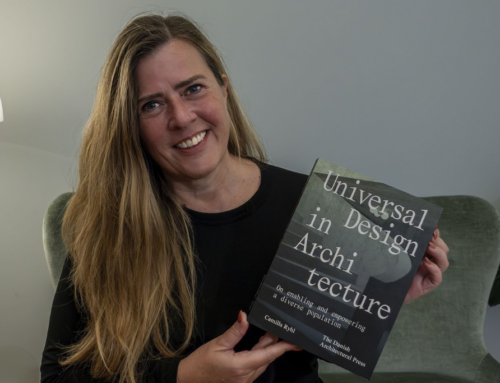
Flower types, benches and winding paths are important components in nursing home gardens for people with dementia
The design and details are important if older adults with dementia are to enjoy the full benefits of a garden. The design should stimulate and challenge the older adults while also accommodating the needs of their visiting families and the staff. Additionally, the garden design should ensure a dementia patient can always find their way back home.
by Nanna Stærmose. The article is published on 11/04/2022.
There are a lot of considerations that go into designing a garden for elderly people with dementia if they, their families, and the staff are to really benefit from it. It’s far from being as simple as being able to open a door out to a lawn, which is something Tanja Schmidt, a postdoc at the University of Southern Denmark’s Department of Sports Science and Clinical Biomechanics, knows a thing or two about. She is currently managing a research project called DeRUde – Dementes Rehabiliterende Udeområder (Rehabilitative Outdoor Spaces for People with Dementia), the aim of which is to collect and develop knowledge about how rehabilitative interventions for people with moderate to severe dementia can be anchored in the establishment of gardens at the nursing homes.
“There are lots of challenges we have to take into account for a dementia-friendly garden to have its full effect. For instance, it’s important to ensure that a person with dementia cannot get lost, which we can solve by establishing footpaths around the garden in a figure-eight design so that they always end up back at their starting point,” said Schmidt.
Most people with dementia will increasingly develop additional symptoms as the disease progresses, referred to as BPSD (Behavioural and Psychological Symptoms of Dementia).
“We know that access to nature and green spaces has a positive effect on BPSD symptoms among older adults suffering from dementia. But people with dementia are different; while some might feel joy from inhaling the scent of a rose, others avoid getting outbursts of anger by getting the opportunity to pet a rabbit. Not everyone needs the same kind of stimulation and care, and we have to incorporate that fact into the design of a dementia-friendly garden,” said Schmidt.
Plants, animals and small personal spaces
Many nursing homes have a garden, but it is not always being used. According to Schmidt, one of the challenges is that the care staff is not used to include visits to the garden into their working day. “The staff often mention time as a significant barrier to taking the nursing home residents outside. That’s why it’s important that they understand that visiting the garden can ultimately ease their work, as it may help the residents become less upset or sleep better at night,” said Schmidt.
She has identified three crucial dimensions that are important to fulfil if a dementia garden is to be rehabilitative for the person with dementia: Social and rehabilitative activities, sensory stimulation and the physical environment.
The dimension of social activities has to do with creating an outdoor space that provides opportunities for social interaction, but which also contains smaller limited spaces for people who struggle with too much sensory input or having too many people around them. “Small spaces are important; small pockets that can provide calm and privacy,” said Schmidt.
One type of rehabilitative activity that has been found to be helpful is recognisable and meaningful gardening activities, such as growing tomatoes and herbs or tending to chickens and other animals. Having something to take care of can be a great source of joy, Schmidt noted, but of course, there are a lot of considerations involved in offering older adults with dementia a chicken coop to look after.
“Many of these measures, both in relation to animals but also in terms of generally tending to a garden, require a number of volunteers who are willing to help out at the nursing home,” said Schmidt.
Sensory stimulation has to do with stimulating the senses of smell, sight and touch among older adults with dementia. This could include providing a variety of plants, the opportunity to touch a piece of bark or seeing water, for example. “In terms of the senses, we are even looking at what types of flowers work; some are lovely to look at, while others are fragrant. One type of flower might stimulate some patients, while others would receive too many stimuli from sitting in a fragrant rose garden,” said Schmidt.
The final dimension is the physical environment. In addition to the footpath system having a looping design – such as a figure-eight – it is also important that the surface is easy to walk on when using a walker or for a relative to take their wheelchair-bound mother around for a stroll. Benches where a person can rest and enjoy the garden with their family, as well as, well-placed toilet facilities, are also important. “Having a toilet within reach seems to be important. Staff may be reluctant to take a resident outside if it’s too much trouble getting to a toilet within a reasonable time,” said Schmidt.
Finally, there are some challenges related to safety in a garden designed for older adults with dementia, including ensuring that there are handrails for the older adult to lean on and removing all toxic plants.
“There are a lot of details to consider, and our hope with this project is to get an even better understanding of what works, which will allow us to create future solutions that improve the quality of life for older adults with dementia,” said Schmidt.
Facts
Tanja Schmidt has been a project manager of the research project DeRUde – Dementes Rehabiliterende Udeområder (Rehabilitative Outdoor Spaces for People with Dementia) since 2019.
The project is a collaboration with Professor (MSO) Ulrika Stigsdotter at the University of Copenhagen’s Department of Earth Science and Nature Management, as well as Chief Physician Lene Wermuth at Slagelse Hospital’s Memory Clinic.
So far, the project has examined research conducted in Denmark and abroad as well as experiences from practitioners in the area.
The next step is to develop and test different measures in relation to designing and establishing a garden that is optimally suited to support rehabilitation of older adults with dementia.
The goal is to publish an inspiration catalogue that can be sent out to all nursing homes in Denmark.

Tanja Schmidt
Postdoc researcher at the University of Southern Denmark’s Department of Sports Science and Clinical Biomechanics
Former member of the Bevica Foundation’s research network
Read more research profiles




